The term "Volksdeutsche" evokes the worst possible associations. Conformist, salesman, teammate. After the Second World War, however, nearly two and a half million people had "German papers". Could it be that they were all traitors?
For people living outside the Reich, but who considered themselves Germans and wanted to adopt German citizenship, the Nazis created two exclusive categories - the first for active political people of German origin, and the second - for people who cultivate German culture, who use the German language on a daily basis, but politically passive.
There was no shortage of people willing. Apart from the German minorities scattered across the territory of the Republic of Poland, the inhabitants of the General Government constituted the largest percentage of the applicants. But the matter was not only related to the territory of Poland. The Germans inhabiting the territories of the USSR and the rest of the conquered Europe were a significant group.
Return to the Reich
It was with these Volksdeutchers (group I) and Deutschestammigers (group II) in mind that the Heim ins Reich program was created (Return to the Reich), the implementation of which began immediately after the Nazis entered Poland. Massive population of the new lands of the Reich began by Germans from Lithuania, Switzerland, Czechoslovakia, Belgium and France.

Polish Volksmen joyfully greet German soldiers (source:Bundesarchiv, license:CC BY-SA 3.0 de).
In 1942, Albert Forster, the governor of the Reich District of Gdańsk-West Prussia, reported that almost nine hundred thousand people had signed the German National List. It was quite a success, especially considering the task set by the ambitious Nazi. In ten years he wanted to completely Germanise Pomerania.
However, as historians enumerate, voluntary signatures were only a small part - about one hundred and eighty thousand names . The rest had to be persuaded somehow.
Arguments for
Leon Pawlikowski recalls that in Bydgoszcz a message was issued according to which only families that signed national lists could count on their fuel allocation . However, if anyone thinks that the threat of a cold winter was the only argument for signing the letter, he is mistaken.

The article was inspired by Artur Baniewicz's crime novel "Five days with a swastika", just published by Znak Horyzont!
In the area of Upper Silesia, managed by Fritz Bracht, there was a nursery rhyme showing the true face of the choice, faced by Polish citizens considered by Nazi researchers of the race to be partially and temporarily polonized , thus meeting the conditions for re-Germanization: If you do not sign, your fault - they will send you to Auschwitz; And when you sign up, you old ass, Hitler will send you to the Ostfront soon.
Temporary Germany for the army
Both Bracht and Forster pursued a liberal policy of Germanization towards Poles. This meant more or less that in principle anyone who met the basic racial requirements could enter the national list . The only difference is that two separate groups of citizenship have been created for them.
Therefore, the most common group was III - Eingedeutsche. Citizenship was granted here temporarily - for a period of ten years, during which everyone was to prove their devotion to the Third Reich. In practice, refusing to sign meant deportation to a concentration camp . The mass Germanization, especially after the defeat at Stalingrad, was to be used overwhelmingly to power up the German army.
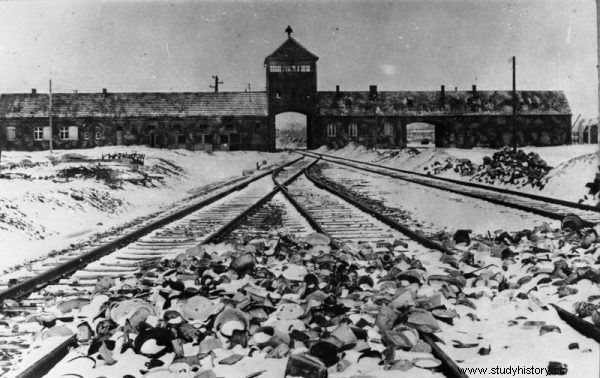
The average person, having the choice of Auschwitz or signing the list, chose the list (source:Bundesarchiv, lic .:CC BY-SA 3.0 de).
The "new Germans" incorporated into the Wehrmacht were, however, treated by their front comrades with contempt and reserve, and could, in principle, only serve in the land forces. Anyway, mass desertions were the order of the day. As Augustyn Stolarski, who was incorporated into the Wehrmacht, emphasized, most of the men sent to the front in German uniforms did not even speak German.
Little ardent love for the Führer
The numbers make it clear that adopting German citizenship and loyalty to Hitler are two separate issues. Although nearly ninety percent of Silesians had German papers, only eight thousand people had NSDAP ID cards . The German archives also recorded just over 700 appeals for a higher civic category.
This article has more than one page. Please select another one below to continue reading.Attention! You are not on the first page of the article. If you want to read from the beginning click here.
The fourth group of citizenship was the most complex in formal terms and was granted on an exceptional basis. So they were the so-called renegades who had actively cooperated with the Polish authorities in the past . Granting citizenship to Ruckendeutschers was used mainly in the case of high-class specialists, especially those performing key functions in production processes in steel mills and mines in Upper Silesia.
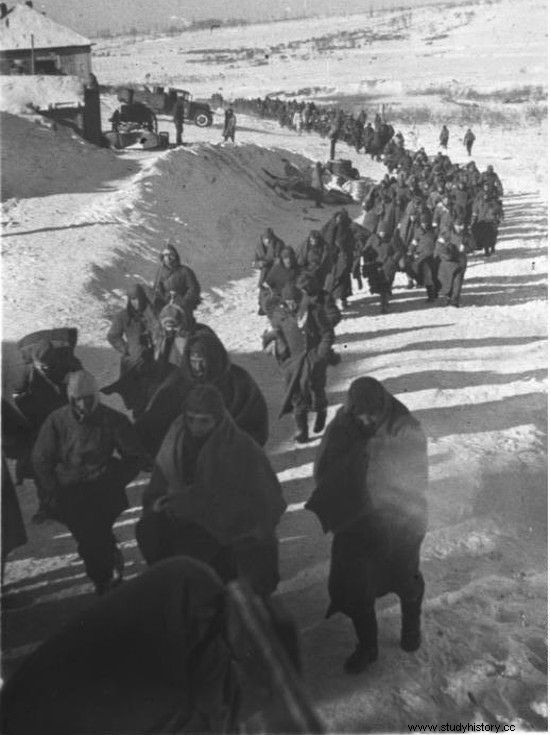
The German army needed fresh blood, especially after the defeat at Stalingrad. In the photo:a column of German prisoners of war on the way to the camp, February 1943 (source:Bundesarchiv, license:CC BY-SA 3.0 de).
Double game
There is no doubt that people who spoke German and had 1st or 2nd group citizenship were extremely valuable to the Polish underground. This was the case of Wilhelmina Gunther, a German woman from a Polonized family from Poznań . Her beloved, a Pole, Antoni Jagła, applied for German citizenship, but before that, he died in Auschwitz.
Wilhelmina Gunther in the winter of 1942 took the oath of a Home Army soldier as the "Wolf". She became a member of the S-VII group. As a Volksdoyan and a police officer of the Peasant Union, she collected important materials for the Polish underground - monitored the mood in the police . Her apartment became a contact point where female liaison officers stayed overnight. She also organized clothing cards for Poles.
When in May 1943 the Gestapo arrested Karol Trojanowski, the head of the Western branch of the Home Army, Gunther was arrested. She was executed on September 9, 1944 for high treason.
Time for revenge
In 1944, so before the Potsdam Conference, the Polish Committee of National Liberation issued a decree according to which after the war mass expulsions and internment of Germans and Volksdeutsche should be started , i.e. those who enjoyed the rights and privileges of belonging to the German nation . Such a formulation may seem quite ruthless when you are aware that for most Poles these privileges were to avoid a camp or to be sent to the eastern front .
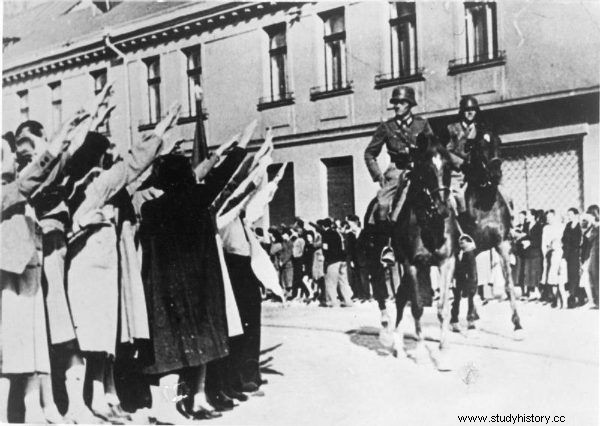
A propaganda photo in which Lodz Volksdeutsche welcomes the German cavalry (source:public domain).
The sense of injustice and the desire for revenge prevented a sober look at the problem of entries on the German National List and its various aspects in individual regions of the country. In the same year, a resolution was adopted on precautionary measures against the traitors of the nation , and immediately after the war, zealously began to implement its provisions.
In the camps abandoned by the Nazis, internment and forced labor centers were created j. Places such as Świętochłowice, Łambinowice, Jaworzno, Mysłowice and Auschwitz have again become the scene of an unimaginable nightmare. With widespread social consent collective responsibility was used, based on excluding hostile elements from the Polish nation .
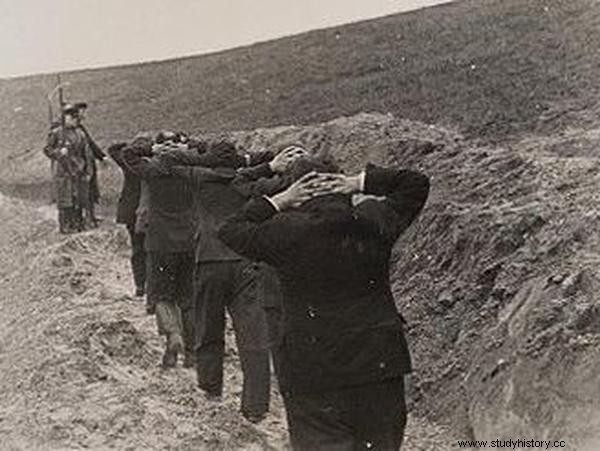
The hatred of collaborators and criminals, such as members of the Selbstschutz, spread to all who signed the Volkslists. In the picture:Selbstschutz members lead Polish teachers to execution (source:public domain).
Among the first detained inhabitants of Silesia women were the majority, and over ten percent of the internees had reached the age of sixty . In the following years, the second, third and fourth group of Volksmen were allowed to rehabilitate on the condition that they swore allegiance to their homeland.
Who betrayed?
Of course, there were real traitors. It is impossible to forget about the flagship example of a collaborator - Wacław Krzeptowski, the notorious singer of Goralenvolk. Krzeptowski and his deputy Józef Cukier not only accepted German citizenship, but also actively and zealously collaborated with the Nazis .
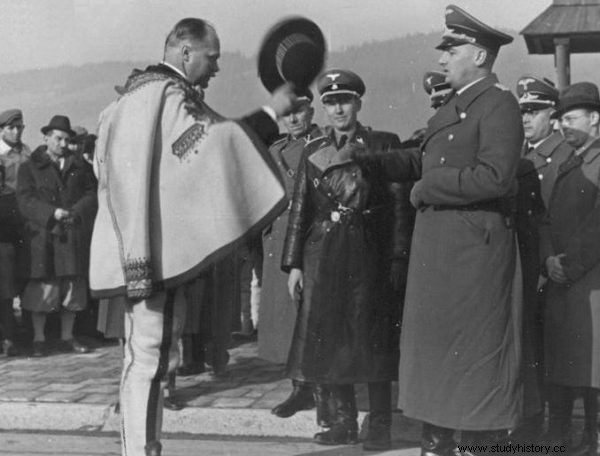
Wacław Krzeptowski pays tribute to Hans Frankow in November 1939 (source:public domain).
On the other hand, just after the outbreak of World War II, nearly fifteen thousand German soldiers joined the Polish army . Among them was the owner of Żywiec - Karol Habsburg, who, considering himself a Pole, refused to sign the list and ended up in a Cieszyn prison. As a result of torture, he lost control in one half of his body and lost sight in one eye.
As the above examples show, the nationality criterion - no matter how restrictively interpreted - is not decisive at all. Identity and the responsibilities that flow from it are a matter of free choice. Often undertaken in dramatic circumstances.
Inspiration:
This article was inspired by the newest novel by Artur Baniewicz titled "Pięć dni ze swastika", just published by Znak Horyzont.
